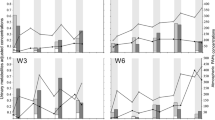Abstract
Urinary hydroxylated metabolites of polycyclic aromatic hydrocarbons (PAH) were investigated as potential biomarkers of bitumen exposure in a cross-shift study in 317 exposed and 117 non-exposed workers. Personal measurements of the airborne concentration of vapours and aerosols of bitumen during a working shift were weakly associated with post-shift concentrations of 1-hydroxypyrene (1-OHP) and 1-, 2+9-, 3- and 4-hydroxyphenanthrenes (further referred to their sum as OHPHE), but not 1- and 2-hydroxynaphthalene (OHNA). Smoking showed a strong influence on the metabolite concentrations, in particular on OHNA. Pre-shift concentrations of 1-OHP and OHPHE did not differ between the study groups (P = 0.16 and P = 0.89, respectively). During shift, PAH metabolite concentrations increased in exposed workers and non-exposed smokers. Statistical modelling of post-shift concentrations revealed a small increase in 1-OHP by a factor of 1.02 per 1 mg/m3 bitumen (P = 0.02) and 1.04 for OHPHE (P < 0.001). A group difference was observed that was diminished in non-smokers. Exposed non-smokers had a median post-shift 1-OHP concentration of 0.42 μg/l, and non-smoking referents 0.13 μg/l. Although post-shift concentrations of 1-OHP and OHPHE were slightly higher than those in the general population, they were much lower than in coke-oven workers. The small content of PAHs in vapours and aerosols of bitumen, the increasing use of additives to asphalt mixtures, the strong impact of smoking and their weak association with airborne bitumen limit the use of PAH metabolites as specific biomarkers of bitumen exposure.


Similar content being viewed by others
References
Angerer J, Ewers U, Wilhelm M (2007) Human biomonitoring: state of the art. Int J Hyg Environ Health 210:201–228
Becker K, Schulz C, Kaus S, Seiwert M, Seifert B (2003) German Environmental Survey 1998 (GerES III). Environmental pollutants in urine of the German population. Int J Hyg Environ Health 206:15–24
Benowitz NL, Hall SM, Stewart S, Wilson M, Dempsey D, Jacob P III (2007) Nicotine and carcinogen exposure with smoking of progressively reduced nicotine content cigarette. Cancer Epidemiol Biomarkers Prev 16:2479–2485
Boffetta P, Burstyn I, Partanen T, Kromhout H, Svane O, Langard S, Jarvholm B, Frentzel-Beyme R, Kauppinen T, Stucker I, Shaham J, Heederik D, Ahrens W, Bergdahl IA, Cenee S, Ferro G, Heikkila P, Hooiveld M, Johansen C, Randem BG, Schill W (2003) Cancer mortality among European asphalt workers: an international epidemiological study. II. Exposure to bitumen fume and other agents. Am J Ind Med 43:28–39
Brandt HC, Watson WP (2003) Monitoring human occupational and environmental exposures to polycyclic aromatic compounds. Ann Occup Hyg 47:349–378
Breuer D (2008) Bitumen (Daempfe und Aeorosole, Mineralöl-Standard). BGIA Method 6305-6311
Breuer D, Hahn JU, Höber D, Emmel C, Musanke U, Rühl R, Spickenheuer A, Raulf-Heimsoth M, Bramer R, Seidel A, Schilling B, Heinze E, Kendzia B, Marczynski B, Welge P, Angerer J, Brüning T, Pesch B (2011) Air sampling and determination of vapours and aerosols of bitumen and polycyclic aromatic hydrocarbons in hot mastic-asphalt applications. Arch Toxicol (for submission)
Buratti M, Campo L, Fustinoni S, Cirla PE, Martinotti I, Cavallo D, Foa V (2007) Urinary hydroxylated metabolites of polycyclic aromatic hydrocarbons as biomarkers of exposure in asphalt workers. Biomarkers 12:221–239
Burstyn I, Kromhout H, Boffetta P (2000) Literature review of levels and determinants of exposure to potential carcinogens and other agents in the road construction industry. AIHAJ 61:715–726
Burstyn I, Boffetta P, Burr GA, Cenni A, Knecht U, Sciarra G, Kromhout H (2002) Validity of empirical models of exposure in asphalt paving. Occup Environ Med 59:620–624
Carmella SG, Chen M, Yagi H, Jerina DM, Hecht SS (2004) Analysis of phenanthrols in human urine by gas chromatography-mass spectrometry: potential use in carcinogen metabolite phenotyping. Cancer Epidemiol Biomarkers Prev 13:2167–2174
Cavallo D, Ursini CL, Bavazzano P, Cassinelli C, Frattini A, Perniconi B, Di FA, Ciervo A, Rondinone B, Iavicoli S (2006) Sister chromatid exchange and oxidative DNA damage in paving workers exposed to PAHs. Ann Occup Hyg 50:211–218
CDC (2005) Third national report on human exposure to environmental chemicals
de Vocht F, Kromhout H, Ferro G, Boffetta P, Burstyn I (2009) Bayesian modelling of lung cancer risk and bitumen fume exposure adjusted for unmeasured confounding by smoking. Occup Environ Med 66:502–508
Hansen AM, Mathiesen L, Pedersen M, Knudsen LE (2008) Urinary 1-hydroxypyrene (1-HP) in environmental and occupational studies—a review. Int J Hyg Environ Health 211:471–503
Hecht SS, Murphy SE, Carmella SG, Li S, Jensen J, Le C, Joseph AM, Hatsukami DK (2005) Similar uptake of lung carcinogens by smokers of regular, light, and ultralight cigarettes. Cancer Epidemiol Biomarkers Prev 14:693–698
Heikkila P, Luotamo M, Pyy L, Riihimaki V (1995) Urinary 1-naphthol and 1-pyrenol as indicators of exposure to coal tar products. Int Arch Occup Environ Health 67:211–217
Herrick RF, Mcclean MD, Meeker JD, Zwack L, Hanley K (2007) Physical and chemical characterization of asphalt (bitumen) paving exposures. J Occup Environ Hyg 4(Suppl 1):209–216
Hoffmann D, Djordjevic MV, Hoffmann I (1997) The changing cigarette. Prev Med 26:427–434
Johnson BA, Rappaport SM (2007) On modelling metabolism-based biomarkers of exposure: a comparative analysis of nonlinear models with few repeated measurements. Stat Med 26:1901–1919
Jongeneelen FJ (2001) Benchmark guideline for urinary 1-hydroxypyrene as biomarker of occupational exposure to polycyclic aromatic hydrocarbons. Ann Occup Hyg 45:3–13
Levin JO, Jarvholm B (1999) Asphalt fumes: exposure to PAH and amines. Am J Ind Med Suppl 1:147–148
Lin YS, Kupper LL, Rappaport SM (2005) Air samples versus biomarkers for epidemiology. Occup Environ Med 62:750–760
Lintelmann J, Angerer J (1999) PAH metabolites, pp 163–187
Loomis D, Kromhout H (2004) Exposure variability: concepts and applications in occupational epidemiology. Am J Ind Med 45:113–122
Marczynski B, Rihs HP, Rossbach B, Holzer J, Angerer J, Scherenberg M, Hoffmann G, Bruning T, Wilhelm M (2002) Analysis of 8-oxo-7,8-dihydro-2′-deoxyguanosine and DNA strand breaks in white blood cells of occupationally exposed workers: comparison with ambient monitoring, urinary metabolites and enzyme polymorphisms. Carcinogenesis 23:273–281
Marczynski B, Pesch B, Wilhelm M, Rossbach B, Preuss R, Hahn JU, Rabstein S, Raulf-Heimsoth M, Seidel A, Rihs HP, Adams A, Scherenberg M, Erkes A, Engelhardt B, Straif K, Kafferlein HU, Angerer J, Bruning T (2009) Occupational exposure to polycyclic aromatic hydrocarbons and DNA damage by industry: a nationwide study in Germany. Arch Toxicol 83:947–957
McClean MD, Rinehart RD, Ngo L, Eisen EA, Kelsey KT, Wiencke JK, Herrick RF (2004) Urinary 1-hydroxypyrene and polycyclic aromatic hydrocarbon exposure among asphalt paving workers. Ann Occup Hyg 48:565–578
McClean MD, Rinehart RD, Sapkota A, Cavallari JM, Herrick RF (2007) Dermal exposure and urinary 1-hydroxypyrene among asphalt roofing workers. J Occup Environ Hyg 4(Suppl 1):118–126
NIOSH (2000) Health effects of occupational exposure to asphalt
Partanen T, Boffetta P (1994) Cancer risk in asphalt workers and roofers: review and meta-analysis of epidemiologic studies. Am J Ind Med 26:721–740
Pesch B, Kappler M, Straif K, Marczynski B, Preuss R, Rossbach B, Rihs HP, Weiss T, Rabstein S, Pierl C, Scherenberg M, Adams A, Kafferlein HU, Angerer J, Wilhelm M, Seidel A, Bruning T (2007) Dose–response modeling of occupational exposure to polycyclic aromatic hydrocarbons with biomarkers of exposure and effect. Cancer Epidemiol Biomarkers Prev 16:1863–1873
Pesch B, Spickenheuer A, Taeger D, Bruning T (2009) Low-dose extrapolation in toxicology: an old controversy revisited. Arch Toxicol 83:639–640
Preuss R, Angerer J (2004) Simultaneous determination of 1- and 2-naphthol in human urine using on-line clean-up column-switching liquid chromatography-fluorescence detection. J Chromatogr B Analyt Technol Biomed Life Sci 801:307–316
Raulf-Heimsoth M, Angerer J, Pesch B, Marczynski B, Hahn JU, Spickenheuer A, Preuss R, Ruhl R, Rode P, Bruning T (2008) Biological monitoring as a useful tool for the detection of a coal-tar contamination in bitumen-exposed workers. J Toxicol Environ Health A 71:746–750
Raulf-Heimsoth M, Pesch B, Rühl R, Brüning T (2011a) The human bitumen study: executive summary. Arch Toxicol (for submission)
Raulf-Heimsoth M, Marczynski B, Spickenheuer A, Pesch B, Welge P, Rühl R, Bramer R, Kendzia B, Heinze E, Angerer J, Brüning T (2011b) Bitumen workers handling mastic versus rolled asphalt in a tunnel—assessment of exposure and biomarkers of irritation and genotoxicity. Arch Toxicol (for submission)
Rihs HP, Pesch B, Kappler M, Rabstein S, Rossbach B, Angerer J, Scherenberg M, Adams A, Wilhelm M, Seidel A, Bruning T (2005) Occupational exposure to polycyclic aromatic hydrocarbons in German industries: association between exogenous exposure and urinary metabolites and its modulation by enzyme polymorphisms. Toxicol Lett 157:241–255
Seidel A, Spickenheuer A, Straif K, Rihs HP, Marczynski B, Scherenberg M, Dettbarn G, Angerer J, Wilhelm M, Bruning T, Jacob J, Pesch B (2008) New biomarkers of occupational exposure to polycyclic aromatic hydrocarbons. J Toxicol Environ Health A 71:734–745
Sobus JR, Waidyanatha S, Mcclean MD, Herrick RF, Smith TJ, Garshick E, Laden F, Hart JE, Zheng Y, Rappaport SM (2009) Urinary naphthalene and phenanthrene as biomarkers of occupational exposure to polycyclic aromatic hydrocarbons. Occup Environ Med 66:99–104
Taussky HH (1954) A microcolorimetric determination of creatine in urine by the Jaffe reaction. J Biol Chem 208:853–861
Umweltbundesamt (1998) Umwelt-survey 1998—PAK-Metaboliten im Urin. Umweltbundesamt, Dessau (in German)
Vaananen V, Hameila M, Kontsas H, Peltonen K, Heikkila P (2003) Air concentrations and urinary metabolites of polycyclic aromatic hydrocarbons among paving and remixing workers. J Environ Monit 5:739–746
Wilhelm M, Hardt J, Schulz C, Angerer J (2008) New reference value and the background exposure for the PAH metabolites 1-hydroxypyrene and 1- and 2-naphthol in urine of the general population in Germany: basis for validation of human biomonitoring data in environmental medicine. Int J Hyg Environ Health 211:447–453
Acknowledgments
The Human Bitumen Study was initiated by the German Committee for Hazardous Substances (AGS) and the German Bitumen Forum and financially supported by: German Social Accident Insurance (DGUV), Eurobitume, Deutscher Asphaltverband e.V., Concawe, Zentralverband des Deutschen Dachdeckerhandwerks, Industrieverband Bitumen-, Dach- und Dichtungsbahnen e.V., Berufsgenossenschaft Rohstoffe und Chemische Industrie (BG RCI) and Aksys GmbH, Beratungsstelle Gussasphaltanwendungen (bga), BG BAU, and Arbeitsgemeinschaft der Bitumenindustrie (Arbit). We thank all workers having participated in the Human Bitumen Study. We gratefully acknowledge the support of the field team especially Anne Flagge, Anja Molkenthin, Bianca Wachter, Dieter Höber, Gerd Zoubek, and in parts of the study Klaus Schott (†) and Hans-Jürgen Schicker.
Author information
Authors and Affiliations
Corresponding author
Electronic supplementary material
Below is the link to the electronic supplementary material.
Rights and permissions
About this article
Cite this article
Pesch, B., Spickenheuer, A., Kendzia, B. et al. Urinary metabolites of polycyclic aromatic hydrocarbons in workers exposed to vapours and aerosols of bitumen. Arch Toxicol 85 (Suppl 1), 29–39 (2011). https://doi.org/10.1007/s00204-011-0680-7
Received:
Accepted:
Published:
Issue Date:
DOI: https://doi.org/10.1007/s00204-011-0680-7




